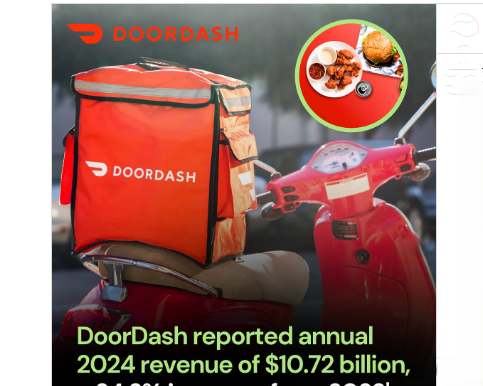DoorDash has become more than just a delivery service in recent months; it is also a highly successful platform for revolutionizing local business. With a market valuation of almost $87 billion and a current price of $204.58, DASH is becoming more well-known for reasons other than late-night burrito runs. Like streaming disrupted television, it is reshaping logistics and emerging as a surprisingly resilient tech player.

By emphasizing the merchant and customer experience, DoorDash has significantly increased the adaptability of its platform. It’s quickly developing into an immensely flexible infrastructure for last-mile delivery, order fulfillment, and small business expansion; it’s no longer just the app you open when you’re too exhausted to cook.
DoorDash Inc. – Business Overview and Key Financials
| Attribute | Details |
|---|---|
| Ticker Symbol | DASH |
| Current Price (May 2025) | $204.58 |
| Market Cap | $86.69 Billion |
| 52-Week Range | $99.32 (Low) – $215.25 (High) |
| Services Offered | DoorDash & Wolt Marketplaces, Drive logistics, Ads, Memberships (DashPass, Wolt+) |
| White-Label Delivery | DoorDash Drive, Wolt Drive |
| Geographic Reach | Active in over 30 countries |
| Dividend Yield | Not applicable |
| Beta (Volatility) | 1.66 |
| Official Website | https://www.doordash.com , Instagram |
A Platform Reimagined: Into Full-Stack Commerce and Beyond Food
DoorDash has improved routing logistics and drastically decreased delivery inefficiencies by combining data analytics and AI-driven technologies. As a result, the operation is extremely efficient and can adjust to changes in demand in real time. Consider it as a GPS for commerce in general, not just for drivers: it directs resources to the areas where they are most needed.
With especially cutting-edge features like merchant-facing ad tech and subscription models that keep users locked into the platform, DoorDash has grown its ecosystem over the past 12 months. Using built-in promotional tools to attract new customers has been remarkably similar for small and medium-sized restaurants to what Etsy did for independent artists.
From Side Project to Platform Superstar
Millions of households relied on DoorDash during the pandemic. However, it has developed into something much more powerful in the years that have passed. The company has remarkably expanded its operations in Europe and the Middle East, where delivery infrastructure was previously dispersed, through strategic alliances and well-timed acquisitions, like its $8 billion acquisition of Wolt.
By utilizing these resources, DoorDash has emerged as a striking illustration of how technology can bring hyperlocal economies together. Even its advertising strategy, which was once thought to be experimental, has significantly improved as a revenue generator, leading to higher margins and better merchant retention.
Long-Term Planning: Putting Money Into Infrastructure, Not Just Takeout
At one point, DoorDash seemed like a risky investment to early-stage investors. However, since going public, the company has evolved from a gig economy sensation to a logistics platform that is here to stay. Its white-label products are incredibly successful at allowing brands to keep their identity while contracting with a reliable partner to handle delivery.
DASH has been surprisingly cheap in relation to future earnings, especially in light of tighter margins across the tech industry and rising interest rates. Additionally, every penny is being used to improve its data systems, grow globally, and create sustainable logistics pipelines—all without paying out dividends.
There are still risks, but there are also rewards
Of course, outside threats can still affect DoorDash. There is a lot of regulatory pressure, especially with regard to the classification of gig workers. Amazon and Uber Eats are becoming more and more competitive. Additionally, consumers may start to protest service fees and surcharges as they become more fee-conscious.
Nevertheless, DoorDash maintains its exceptional adaptability to change by consistently changing its business model. In this industry, it’s one of the few platforms where the user experience, logistics, and technology are all expanding simultaneously.
Should Your Portfolio Include DASH?
It is anticipated that DoorDash will further evolve into the Shopify of local commerce in the upcoming years, simplifying transactions, revolutionizing delivery, and fostering the digital success of microbusinesses. DASH may be your best option if you’re searching for a stock that combines platform agility with strong infrastructure and an ambitious roadmap.
